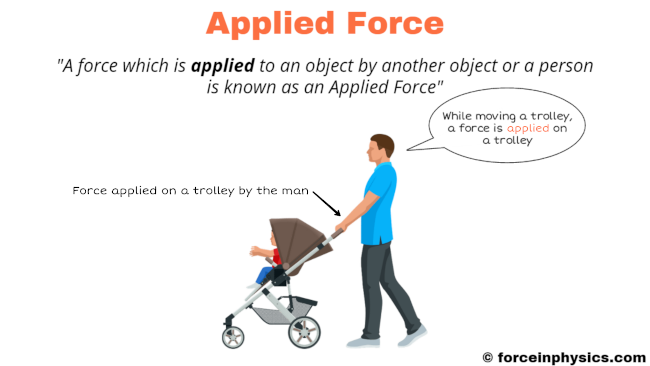
An applied force is the force exerted on an object by another object or a person through direct physical contact. It can lead to changes in the object’s motion or state. For instance, consider a man pushing a pram from behind. In this scenario, the man exerts an applied force on the pram, which causes it to move forward. Similarly, when a person pushes a door, the applied force leads to the door opening or closing. The effect of the applied force depends on the strength and direction of the force and the object’s resistance to motion or deformation.
Examples
Light switch
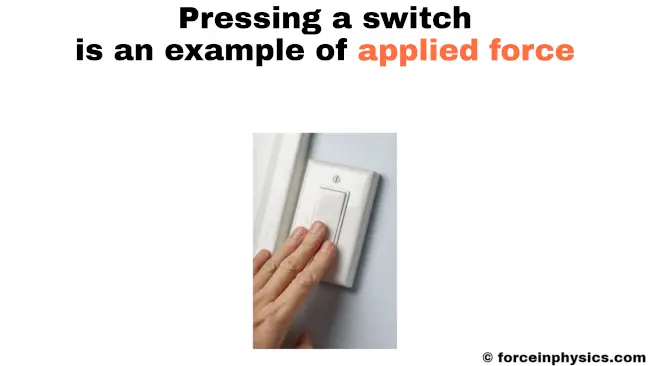
When a light switch is operated to turn the lights on or off, an applied force is at play. This force, typically exerted by using a hand, allows for the control of the lights in the room. The action of pushing or flipping the switch involves the application of force, wherein one object (the hand) applies force to another object (the switch). Through this applied force, the state of the switch changes, and the flow of electricity to the lights is controlled, resulting in either illumination or deactivation.
Plastic bottle
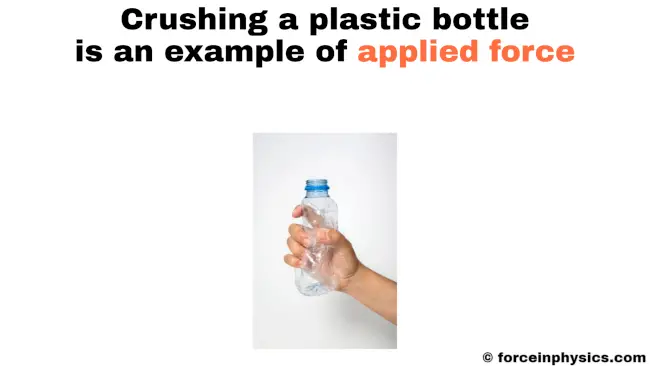
When a plastic bottle is subjected to force, such as pressing or squeezing with the hand, it serves as an example of an applied force. The application of force to the bottle induces deformation, which results in crushing or compression. This action demonstrates how an external force, in this case, the force exerted by the hand, can alter the shape and structure of the plastic bottle. By applying force, the original form of the bottle changes, and this showcases the concept of applied force in action.
Book
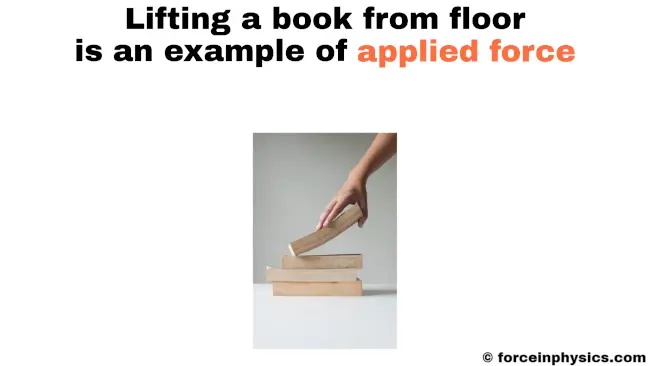
When a book is resting on a surface, such as a desk or table, it can be moved or lifted by applying force with the hand. This force exerted on the book by the hand is an example of applied force. Applied force refers to the effort exerted by one object or person on another object. In this scenario, the hand applies force to the book, causing it to move from its initial position, clearly demonstrating the concept of applied force in action.
Stress ball
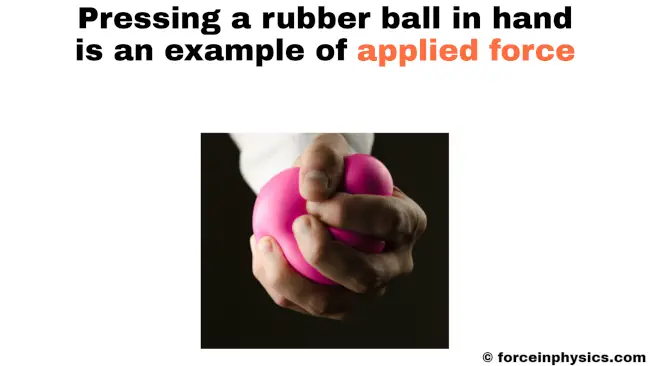
Applying force to a stress ball by pressing it with the hand exemplifies the concept of applied force. As the hand exerts pressure on the soft sponge ball, it undergoes compression, changing its shape and volume. This external force, applied by the hand, showcases the concept of applied force in action, where one object or person exerts effort on another object, resulting in a noticeable change in its state or appearance.
Door
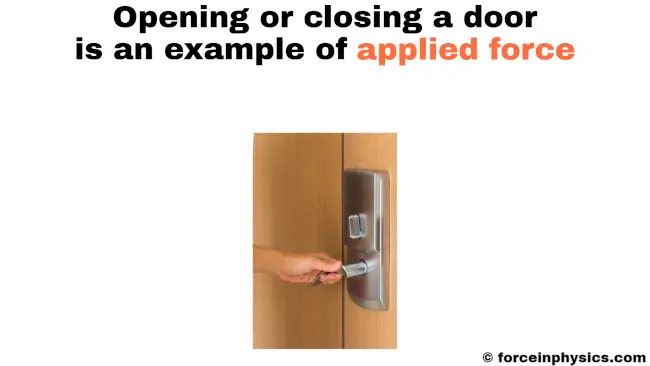
When interacting with a door and using your hand to open or close it, you can feel the force that’s applied. The force exerted by the hand on the door initiates its movement. This demonstration of a hand pushing a door exemplifies applied force. It highlights how objects interact, wherein the action of one object results in the motion of the other. The act of opening or closing a door serves as a practical example of how applied force can bring about changes in the state of an object’s position.
Bow and arrow
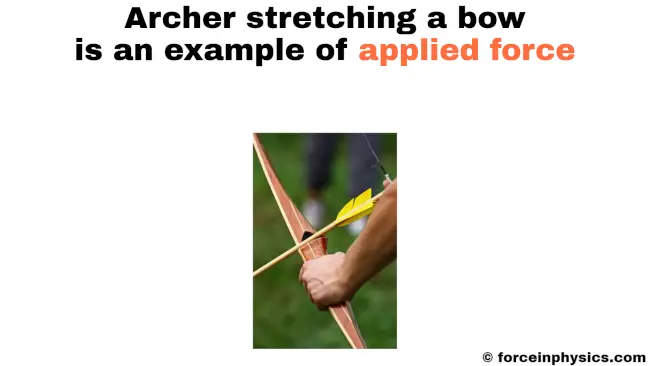
When using a bow and arrow, the applied force is demonstrated as the archer draws the bowstring back. The archer’s hand exerts force on the bow and stores potential energy in it. Upon release, this energy transfers to the arrow and propels it forward with speed and accuracy. The applied force from the archer’s hand is essential for transferring the stored energy to the arrow, making it a clear example of applied force.
Pottery
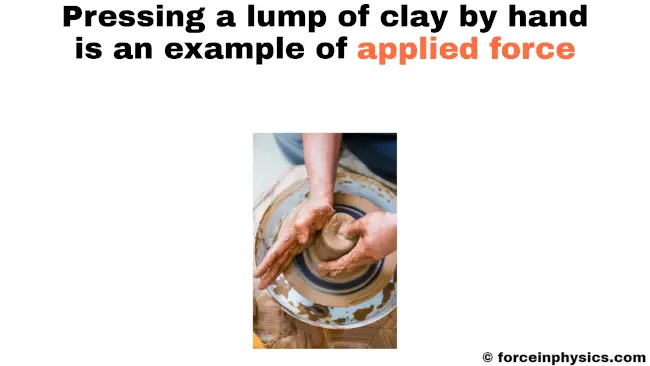
In pottery, applied force is evident when a potter shapes a lump of clay using their hands. By exerting external force on the clay, the potter molds it into the desired form. The hand’s pressure on the clay is an example of applied force, crucial in transforming the shapeless clay into a beautifully crafted pot. Hence, the process of handcrafting clay into pottery showcases the concept of applied force in action.
Soap dispenser
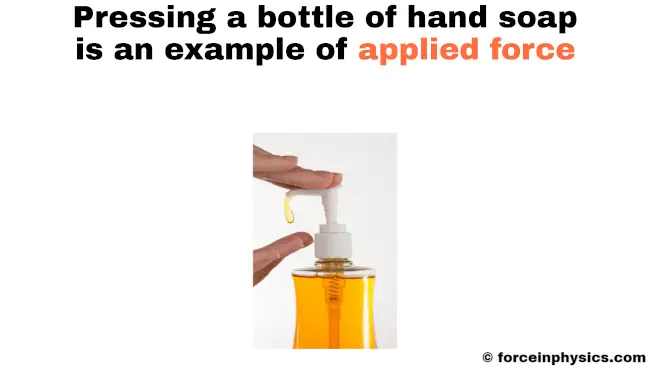
When you press the pump of a soap dispenser, you demonstrate the concept of applied force as the soap dispenses. The finger exerts force on the pump, causing it to dispense the liquid soap. In this scenario, an external object (the finger) applies force to the soap dispenser’s pump, resulting in the desired outcome of soap being released. This straightforward action of dispensing soap illustrates how applied force is used to achieve specific functions. Applied force is therefore a key concept in various everyday activities.
Formula
The applied force formula is expressed as FA = m × a, where FA represents the applied force, m denotes the mass of the object, and a signifies its acceleration. This formula establishes a direct relationship between the applied force on an object and its mass and acceleration. By utilizing this formula, one can accurately calculate the magnitude of the force applied to the object based on its mass and the rate of change in its velocity.
Practice problems
Problem #1
A metal block with a mass of 6 kg is accelerating at 25 m/s2 in the forward direction. Calculate the force applied to cause this accelerated motion.
Solution
Given data:
- Mass of the metal block, m = 6 kg
- Acceleration of the metal block, a = 25 m/s2
- Applied force, FA = ?
Using the formula:
- FA = m × a
- FA = 6 × 25
- FA = 150 N
Therefore, the force applied on the metal block is 150 N.
Problem #2
A rubber ball with a mass of 0.5 kg is accelerating at a rate of 10 m/s2. Determine the magnitude of the force applied to cause this acceleration.
Solution
Given data:
- Mass of the rubber ball, m = 0.5 kg
- Acceleration of the rubber ball, a = 10 m/s2
- Applied force, FA = ?
Using the formula:
- FA = m × a
- FA = 0.5 × 10
- FA = 5 N
Therefore, the force applied on the rubber ball is 5 N.
Problem #3
A small toy car, weighing 1.5 kg, is moving forward with an acceleration of 15 m/s2. Determine the force applied to propel the toy car in the forward direction.
Solution
Given data:
- Mass of the toy car, m = 1.5 kg
- Acceleration of the toy car, a = 15 m/s2
- Applied force, FA = ?
Using the formula:
- FA = m × a
- FA = 1.5 × 15
- FA = 22.5 N
Therefore, the force applied on the toy car is 22.5 N.
Problem #4
An object with a mass of 3 kg is experiencing a forward acceleration of 8 m/s2. Determine the applied force that causes this acceleration.
Solution
Given data:
- Mass of an object, m = 3 kg
- Acceleration of an object, a = 8 m/s2
- Applied force, FA = ?
Using the formula:
- FA = m × a
- FA = 3 × 8
- FA = 24 N
Therefore, the force applied on an object is 24 N.
Related
- Balanced force
- Unbalanced force
- Friction
- Tension (physics)
- Applied force
- Normal force
- Drag (physics)
- Gravity
- Centripetal force
- Centrifugal force
- Buoyancy
- Net force
- Compression (physics)
More topics
External links
- Applied Force – University of Tasmania
- Applied Force: Definition, Formula, and Examples – Science Facts
- Types of Forces – The Physics Classroom
- Applied Force | Definition, Types & Examples – Study.com
- Applied Force by Ron Kurtus – Physics Lessons – School for Champions
- How do you find applied force? – Quora
- What is an Applied Force? – AllTheScience
- How to Find Applied Force – Physics Calculations
- Force – Wikipedia
- Relationship between applied and normal force? – Physics Stack Exchange
- Applied Force in Physics Problems – Dummies
- Type of Force – Weebly
- Applied Force Calculator – Calculator Academy
Deep
Forceinphysics.com was founded by Deep Rana, who is a mechanical engineer by profession and a blogger by passion. He has a good conceptual knowledge on different educational topics and he provides the same on this website. He loves to learn something new everyday and believes that the best utilization of free time is developing a new skill.
